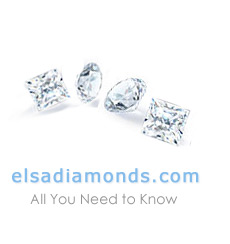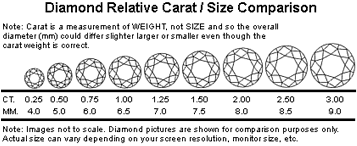
Diamond Carats
Carats are a Diamonds Weight
The measurement of diamonds is calculated in carats. A carat in a diamond is composed of many areas called points. A diamonds carat is one of the 4 c's of diamonds to consider when evaluating a diamond, and it's a term used to describe how much the diamond weighs.
A single diamond carat is equal to the weight of 200 milligrams. Today, few fine diamonds over one carat are sold without a diamond grading report (or certificate, as they are also called) from a respected laboratory. The diamonds price per carat increases with carat weight, since larger diamonds are both rarer and more desirable for use as gemstones.
The price per carat does not increase smoothly with increasing size. Instead, there are sharp jumps around milestone carat weights, as demand is much higher for diamonds weighing just more than a milestone than for those weighing just less. As an example, a 0.95 carat diamond may have a significantly lower price per carat than a comparable 1.05 carat diamond, because of differences in demand.
A weekly diamond price list, the Rapaport Diamond Report is published by Martin Rapaport, CEO of Rapaport Group of New York, for different diamond cuts, clarity and weights. It is currently considered the de-facto retail price baseline. Jewelers often trade diamonds at negotiated discounts off the Rapaport price (e.g., "R -3%").

In the wholesale trade of gem diamonds, carat is often used in denominating lots of diamonds for sale. For example, a buyer may place an order for 100 carats of 0.5 carat, D–F, VS2-SI1, excellent cut diamonds, indicating he wishes to purchase 200 diamonds (100 carats total mass) of those approximate characteristics. Because of this, diamond prices (particularly among wholesalers and other industry professionals) are often quoted per carat, rather than per stone.
Total carat weight (t.c.w.)
TCW is a phrase used to describe the total mass of diamonds or other gemstone in a piece of jewelry, when more than one gemstone is used. Diamond solitaire earrings, for example, are usually quoted in t.c.w. when placed for sale, indicating the mass of the diamonds in both earrings and not each individual diamond. T.c.w. is also widely used for diamond necklaces, bracelets and other similar jewelry pieces.

 Some time ago you both made a promise. A promise to each other. Now it’s time to recognise that you both meant that promise, and that now you both still mean it.
Some time ago you both made a promise. A promise to each other. Now it’s time to recognise that you both meant that promise, and that now you both still mean it.